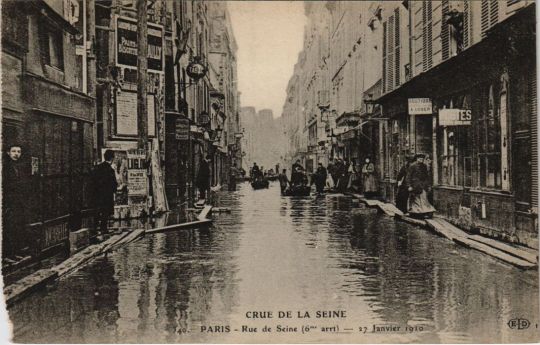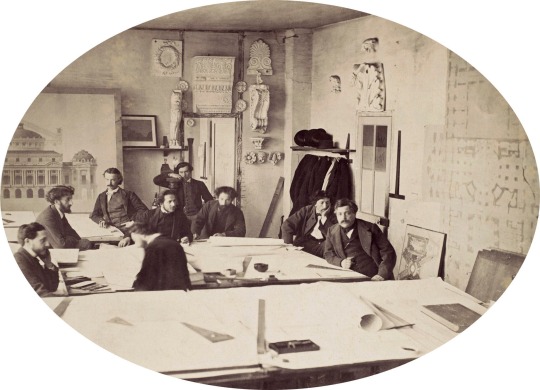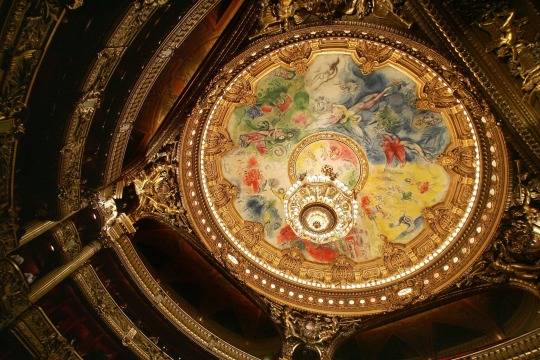#Paris Flood 1910
Explore tagged Tumblr posts
Text

Quay scene in Paris during the 1910 Great Floods
French vintage postcard
#historic#photography#postal#ansichtskarte#quay#photo#sepia#vintage#postcard#great floods#1910#great#briefkaart#scene#postkarte#tarjeta#carte postale#ephemera#floods#paris#postkaart#french
23 notes
·
View notes
Photo


Urbanization level and flood risk in Paris, 1910 vs now.
by @leparisieninfog
96 notes
·
View notes
Photo
100 years ago during the 1910 Great Floods:


Sunset on the Seine. Pont Royal, Paris.
#patrimoine#1910#briefkaart#years#louvre#photography#vintage#100 years ago#tarjeta#postkaart#french#postal#europe#photo#floods#postcard#historic#pont royal#pont#carte postale#flood#bridge#monument#great#ephemera#paris#sepia#france#great floods#ansichtskarte
2K notes
·
View notes
Text

Gaston DANGEREUX (1875-1932)
Flooded street with snow-covered houses in a suburb of Paris, 1910
22 notes
·
View notes
Text

Antoine Barbier - Flooding in Paris, January 1910
122 notes
·
View notes
Text
Rating: G
Words: 3,618
Tags: Andy | Andromache & Booker | Sebastien le Livre & Joe | Yusuf Al-Kaysani & Nicky | Nicolò di Genova, Joe | Yusuf Al-Kaysani/Nicky | Nicolò di Genova, POV Nicky | Nicolò di Genova, Canon Compliant, Historical, Nicky gets a hobby, Booker is obsessed with the Tour de France, Nicky | Nicolò di Genova Loves Joe | Yusuf Al-Kaysani
Summary:
The comet had passed by Earth in the spring of 1066, as bright as a star. Yusuf had been born under its light. And there he stood, still as bright and lively, matching the energy of the incoming comet. Nicolas knew it would not cause the death of all beings on planet Earth. Not when Yusuf still lived. – In a flooded and panicked Paris in 1910, the Old Guard anticipate the arrival of Halley’s Comet.
#tog#the old guard#tog fic#yess bitch i got the writing bug last night#after like three months#here's another little 'snapshots in time' sort of episode#sage writes#to my lovers of gen fics: i love love love love love love love love love love love love you#and i love nicky's autistic ass
37 notes
·
View notes
Photo
During the 1910 Great Floods:


Assemblee Nationale…
#historic#monument#photography#vintage#sepia#france#parliament#photo#parisian#briefkaart#paris#1910#french#ansichtskarte#postcard#floods#patrimoine#great floods#postkarte#postkaart#carte postale#europe#great#flood#ephemera#postal#tarjeta#architecture
23 notes
·
View notes
Photo

Roger Viollet/Getty Images, Paris Flood. 1910.
74 notes
·
View notes
Text
It has been snowing since yesterday, my darling, tirelessly. Today I thought that the bus, which carries the mail, would not reach Cabris and that I would have nothing from you. But the postman came by, though very late. And you tell me that you are cold, my little ice cube, and that you envy my beautiful country, flooded with sunshine! But no, the sky here is made of bad wadding, the valley is white, and the olive trees look like cold ghosts.
It's true that winter is beautiful here and it's awful in Paris. It is true that your house is an absurd fridge while this house is crackling with bright lights. Ah! How happy we would be here, even in winter. Warm up, my little flake! I'd like to melt you in my arms. Just now the radio announced - 8 in Paris. And a warm tenderness came to me, the desire to warm you and protect you, to tell you at least, with all my heart, as I do here. This morning after working a little, I put on my ski boots and pants, a high jumper, and my dear jacket. And I went for a walk on the mountain through the snow. The air stung, my blood was pounding, and my yesterday's sadness was slowly fading away. Everything was white and the silence wonderful. I made good resolutions; to ignore everything except you and my work, not to let me be confused by anything and enjoy only you and my work, etc., etc., etc. I returned home with my eyes flickering with the brightness of the snow, my cheeks fresh, and a new courage in my heart.
I had lunch, read my Delacroix in bed and waited for your letter. She arrived, I was happy, I answer her and then I'll work, so I'll answer you: Good news about Jean and Catherine going to school. It's true that they see mostly movies and puppets. From my time! Good news about my mom. My brother* writes to me, talking about her and her kindness: "This is bread. And what a loaf!" I'll go to the doctor in about ten days and we'll take an x-ray. But yes! Proust was homosexual. I thought you knew that. Go on. You can talk more about it. Bad news, George Orwell is dead**. You don't know him. A very talented English writer, with about the same experience as me (although he was ten years older) and exactly the same ideas. He had been fighting tuberculosis for years. He was one of the very few men with whom I shared something. But let's leave it at that.
The snow is coming down. I don't know how to get this letter to the post office in time. The wind is blowing too. You can't see ten feet in front of you. God! How cold your room must be! Don't curl up too much. Don't disappear completely. Stop at the point. When you're just a dot, I'll still love you and I'll take you in my pocket. I love you in the winter too, you know that, since we've had so few summers to ourselves. But the summer, truthfully, the one we shall live, will come again. And he'll find us full of a new love. I hold you close to me, I warm your hands against my chest, I cover all. See you tomorrow, darling!
Albert Camus to Maria Casarès, Correspondance, January 25, 1950 [#146]
* Lucien, Albert's elder brother, born January 20, 1910 in Algiers.
** The English writer and journalist George Orwell, author of Animal Farm and 1984, died in London on 21 January 1950. His intellectual and personal commitment to social justice and against all forms of totalitarianism brought him closer to Albert Camus.
#albert camus#camus#absurd#absurdism#correspondance#love letters#love#maria casares#snow#cold#sun#sunshine#winter#paris#tenderness#mountain#silence#kindness#summer
21 notes
·
View notes
Text
Events 6.16 (after 1910)
1911 – IBM founded as the Computing-Tabulating-Recording Company in Endicott, New York. 1922 – General election in the Irish Free State: The pro-Treaty Sinn Féin party wins a large majority. 1925 – Artek, the most famous Young Pioneer camp of the Soviet Union, is established. 1930 – Sovnarkom establishes decree time in the USSR. 1933 – The National Industrial Recovery Act is passed in the United States, allowing businesses to avoid antitrust prosecution if they establish voluntary wage, price, and working condition regulations on an industry-wide basis. 1940 – World War II: Marshal Henri Philippe Pétain becomes Chief of State of Vichy France (Chef de l'État Français). 1940 – A Communist government is installed in Lithuania. 1948 – Members of the Malayan Communist Party kill three British plantation managers in Sungai Siput; in response, British Malaya declares a state of emergency. 1955 – In a futile effort to topple Argentine President Juan Perón, rogue aircraft pilots of the Argentine Navy drop several bombs upon an unarmed crowd demonstrating in favor of Perón in Buenos Aires, killing 364 and injuring at least 800. At the same time on the ground, some soldiers attempt to stage a coup but are suppressed by loyal forces. 1958 – Imre Nagy, Pál Maléter and other leaders of the 1956 Hungarian Uprising are executed. 1961 – While on tour with the Kirov Ballet in Paris, Rudolf Nureyev defects from the Soviet Union. 1963 – Soviet Space Program: Vostok 6 mission: Cosmonaut Valentina Tereshkova becomes the first woman in space. 1963 – In an attempt to resolve the Buddhist crisis in South Vietnam, a Joint Communique was signed between President Ngo Dinh Diem and Buddhist leaders. 1972 – The largest single-site hydroelectric power project in Canada is inaugurated at Churchill Falls Generating Station. 1976 – Soweto uprising: A non-violent march by 15,000 students in Soweto, South Africa, turns into days of rioting when police open fire on the crowd. 1977 – Oracle Corporation is incorporated in Redwood Shores, California, as Software Development Laboratories (SDL), by Larry Ellison, Bob Miner and Ed Oates. 1981 – US President Ronald Reagan awards the Congressional Gold Medal to Ken Taylor, Canada's former ambassador to Iran, for helping six Americans escape from Iran during the hostage crisis of 1979–81; he is the first foreign citizen bestowed the honor. 1989 – Revolutions of 1989: Imre Nagy, the former Hungarian prime minister, is reburied in Budapest following the collapse of Communism in Hungary. 1997 – Fifty people are killed in the Daïat Labguer (M'sila) massacre in Algeria. 2000 – The Secretary-General of the UN reports that Israel has complied with United Nations Security Council Resolution 425, 22 years after its issuance, and completely withdrew from Lebanon. The Resolution does not encompass the Shebaa farms, which is claimed by Israel, Syria and Lebanon. 2002 – Padre Pio is canonized by the Roman Catholic Church. 2010 – Bhutan becomes the first country to institute a total ban on tobacco. 2012 – China successfully launches its Shenzhou 9 spacecraft, carrying three astronauts, including the first female Chinese astronaut Liu Yang, to the Tiangong-1 orbital module. 2012 – The United States Air Force's robotic Boeing X-37B spaceplane returns to Earth after a classified 469-day orbital mission. 2013 – A multi-day cloudburst, centered on the North Indian state of Uttarakhand, causes devastating floods and landslides, becoming the country's worst natural disaster since the 2004 tsunami. 2015 – American businessman Donald Trump announces his campaign to run for President of the United States in the upcoming election. 2016 – Shanghai Disneyland Park, the first Disney Park in Mainland China, opens to the public. 2019 – Upwards of 2,000,000 people participate in the 2019–20 Hong Kong protests, the largest in Hong Kong's history.
1 note
·
View note
Text



.
A little bit of Notting Hill in Paris.
Isn’t it funny how you noticed things differently after you travel to some places.
Rue Crémieux was built in 1857 as workers' housing. The street has been widely recommended to tourists for its quaint painted housefronts, and has become a popular destination for filming and for social media photos as most of the house-fronts are painted in pastel colours. It has been compared to Portobello Road in London and the Venetian island of Burano.
During the 1910 Great Flood of Paris, the water from the Seine reached as high as 1.75 metres (5.7 ft) on one of the buildings. A commemorative plaque marks the location.

5 notes
·
View notes
Text

Street scene in the 6th district of Paris during the 1910 Great Floods
French vintage postcard
#vintage#tarjeta#6th#old#th#briefkaart#1910#street#postcard#photography#postal#carte postale#sepia#ephemera#great#district#historic#paris#french#ansichtskarte#postkarte#scene#great floods#postkaart#floods#photo
23 notes
·
View notes
Text
The Haussmann Renovations
One thing I see overlooked often in literature, movies, and the media, is how Paris looked pre-1850s. Paris was a completely different city before Napoleon III decided to demolish vast portions of it and rebuild it in his own more “modern” image.
This is a map of Paris in the 1840s: https://fineartamerica.com/featured/map-of-paris-and-the-outskirts-in-1840-french-school.html
You can zoom in to various parts to find little alleyways, streets, buildings, and squares. Taking the century before the 1850s into consideration, Napoleon had good reason to recreate Paris. This is what it looked like:

The barricades and revolutionary fervor of the desperate urban poor, at that point concentrated in the center of Paris, were not unknown. Several revolutions had come and gone, the most notable of which involved the first Napoleon, and so for someone looking to consolidate power this was a good idea.
The movie Les Miserables, portraying the June Revolution in 1832, makes Paris look like this, but the barricades do play a prominent role:

Open areas like this were truly a one-of-a-kind occurrence in Paris (though if this is the champ de mars, this makes sense). Napoleon III’s renovations are called the Haussmann Renovations. The result of these construction projects made Paris look something more like this:

or for a more grounded view, during a flood in the 1910s:

It made Paris known for wide boulevards and neighborhoods arranged in this sort of orderly star pattern. The place looks nice, but it took the dismantling of an entire group of people and their homes to accomplish that. I wouldn’t condone that type of activity, personally, though, for people like the French who had been through what they had been through, it may be understandable.
You can read more about the 20 years of urban planning in this Wikipedia article: https://en.wikipedia.org/wiki/Haussmann's_renovation_of_Paris
(remember the standard Wikipedia caveats.) If you have any interesting tidbits about this I’d love to hear them. What I know of this is from an old college class, and given the current state of publishing and research, that may be all I know for a while.
Thanks for reading. Wish me luck with my future research.
2 notes
·
View notes
Text
a new article about palais garnier! :D
An Opera House Inspired by More Than Music
The architecture and location of the Palais Garnier are intertwined with the history of France and Paris (and a famous phantom).

By Sam Lubell
Jan. 24, 2023
Showcasing more than 400 performances of opera, dance and music each year, Charles Garnier’s Paris Opera, inaugurated in 1875, is a true cathedral of culture.
A promenade through its rooms is a theatrical experience itself, revealing ornate marble columns, bronze statues, crystal chandeliers, and paintings and frescoes. But the Palais Garnier, as the building is known, also holds secrets, from design quirks to haunting tales. Here are some facts about the building.
Charles Garnier, the architect, was the last one shortlisted for the project.
Emperor Napoleon III started a competition for an “Imperial Academy of Music and Dance” in December 1860. Five finalists were chosen from more than 170 proposals. They were ranked, and Garnier came in last. With little to lose, he changed his plans, creating a monumental structure layered with imposing arcades, colonnades and flanking pavilions, crowned with a dome and a pedimented tower. “He was using a classical language, but in an eclectic, much freer, and much more expressive way,” Christopher Mead, author of “Charles Garnier’s Paris Opera: Architectural Empathy and the Renaissance of French Classicism,” said in an interview. Garnier’s win shocked the establishment, Mr. Mead said, but worked with the emperor’s effort to cast himself as a reformer.

There is a “lake” under the opera house.
When digging the foundations, workers hit a hidden arm of the Seine, causing water to flood the site. It was impossible to remove all the water, so crews had to contain it with a massive concrete reservoir with a vaulted ceiling from which water is still pumped today. The so-called lake was dramatized by Gaston Leroux, author of “The Phantom of the Opera,” who made it the stomping grounds of the Phantom. Mr. Mead was mesmerized by a visit. “You can see why it inspired Leroux,” he said. “You could invent a whole world there.”
The falling chandelier in “The Phantom of the Opera” was based on a real event.
In 1896, during a performance of Étienne-Joseph Floquet’s opera “Hellé,” a short-circuit caused a counterweight from the chandelier to fall, killing a woman in the audience and injuring several more people. Reporting on the event was Leroux, then a journalist with a Paris newspaper. In “The Phantom of the Opera,” it is the Phantom who dislodges the chandelier from the ceiling.

So was the Phantom (sort of).
Leroux first published his novel as a serial in 1909 and 1910. In an interview, Isabelle Rachelle Casta, author of “The Work of ‘Obscure Clarity’ in ‘The Phantom of the Opera’ by Gaston Leroux,” said its characters and story were invented but drew from real-life elements in addition to the lake and the falling chandelier. The Phantom himself was inspired by a pianist who was disfigured after an 1873 fire at the Palais Garnier’s precursor, the Salle Le Peletier, and from an assistant to Garnier who disappeared during construction. “Leroux took all of these stories and he created one of the most important stories of the 20th century,” Ms. Casta said.
An attack partly inspired the construction.
In 1858, Napoleon III and his wife, Empress Eugènie, went to the Salle Le Peletier for a concert. As they arrived, three bomb blasts threw their carriage onto its side, hurled spectators into the street and blew out windows in the opera house and surrounding buildings. Eight people died, but the emperor and empress survived. The mastermind of the plot was Felice Orsini, an Italian revolutionary who had been critical of Napoleon III for not supporting his pro-republican cause. The emperor, already hoping to replace the Salle Le Peletier, decided to build a new opera house in a more open area with a secure entrance. But he never saw it completed: He died in 1873.
Garnier requested that no trees be planted on the main road to the building.
Baron Georges-Eugène Haussmann, who oversaw Napoleon III’s transformation of Paris, lined all his Grands Boulevards with trees, except for one: the Avenue de l’Opéra, a half-mile stretch from the Louvre to the opera house. Garnier asked for this to maximize his building’s sense of monumentality and to not block views of it. “He wanted a building that announced itself to the public,” Mr. Mead said. “This was a building for them.”
A version of this article appears in print on Jan. 25, 2023, Section A, Page 9 in The New York Times International Edition
0 notes

